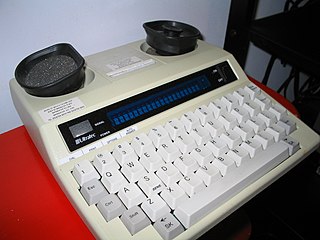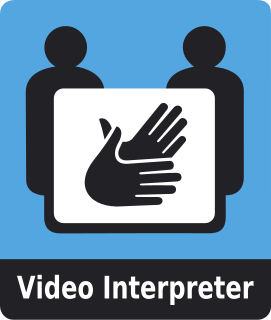Voice over Internet Protocol (VoIP), also called IP telephony, is a method and group of technologies for the delivery of voice communications and multimedia sessions over Internet Protocol (IP) networks, such as the Internet. The terms Internet telephony, broadband telephony, and broadband phone service specifically refer to the provisioning of communications services over the Internet, rather than via the public switched telephone network (PSTN), also known as plain old telephone service (POTS).

A pager is a wireless telecommunications device that receives and displays alphanumeric or voice messages. One-way pagers can only receive messages, while response pagers and two-way pagers can also acknowledge, reply to and originate messages using an internal transmitter.

Text messaging, or texting, is the act of composing and sending electronic messages, typically consisting of alphabetic and numeric characters, between two or more users of mobile devices, desktops/laptops, or another type of compatible computer. Text messages may be sent over a cellular network, or may also be sent via an Internet connection.

A telecommunications device for the deaf (TDD) is a teleprinter, an electronic device for text communication over a telephone line, that is designed for use by persons with hearing or speech difficulties. Other names for the device include teletypewriter (TTY), textphone, and minicom.

A telecommunications relay service, also known as TRS, relay service, or IP-relay, or Web-based relay service, is an operator service that allows people who are deaf, hard of hearing, deafblind, or have a speech disorder to place calls to standard telephone users via a keyboard or assistive device. Originally, relay services were designed to be connected through a TDD, teletypewriter (TTY) or other assistive telephone device. Services gradually have expanded to include almost any real-time text capable technology such as a personal computer, laptop, mobile phone, PDA, and many other devices. The first TTY was invented by deaf scientist Robert Weitbrecht in 1964. The first relay service was established in 1974 by Converse Communications of Connecticut.
Broadvoice is a privately owned company headquartered in Northridge, California. They provide Voice over IP (VoIP) cloud-based telecommunications services to small, medium and enterprise businesses in the United States. Broadvoice offers telephone services, UCaaS, SIP Trunking, telecommunications network and security, along with virtual call centers so business customers can use voice and video communications via a broadband Internet connection or cellular phone.

An intercom, also called an intercommunication device, intercommunicator, or interphone, is a stand-alone voice communications system for use within a building or small collection of buildings, functioning independently of the public telephone network. Intercoms are generally mounted permanently in buildings and vehicles. Intercoms can incorporate connections to public address loudspeaker systems, walkie talkies, telephones, and to other intercom systems. Some intercom systems incorporate control of devices such as signal lights and door latches.

Skype for Business Server is real-time communications server software that provides the infrastructure for enterprise instant messaging, presence, VoIP, ad hoc and structured conferences and PSTN connectivity through a third-party gateway or SIP trunk. These features are available within an organization, between organizations and with external users on the public internet or standard phones.

Videotelephony, also known as videoconferencing and video teleconferencing, is the two-way or multipoint reception and transmission of audio and video signals by people in different locations for real time communication. A videophone is a telephone with a video camera and video display, capable of simultaneous video and audio communication. Videoconferencing implies the use of this technology for a group or organizational meeting rather than for individuals, in a videoconference. Telepresence may refer either to a high-quality videotelephony system or to meetup technology, which can go beyond video into robotics. Videoconferencing has also been called "visual collaboration" and is a type of groupware.
In computing, phoning home is a term often used to refer to the behavior of security systems that report network location, username, or other such data to another computer.

A video relay service (VRS), also sometimes known as a video interpreting service (VIS), is a video telecommunication service that allows deaf, hard-of-hearing, and speech-impaired (D-HOH-SI) individuals to communicate over video telephones and similar technologies with hearing people in real-time, via a sign language interpreter.
A medical alarm is an alarm system designed to signal the presence of a hazard requiring urgent attention and to summon emergency medical personnel. Other terms for a medical alarm are Personal Emergency Response System (PERS) or medical alert.
Next Generation 9-1-1 refers to an initiative aimed at updating the 9-1-1 service infrastructure in the United States and Canada to improve public emergency communications services in a growing wireless mobile society. In addition to calling 9-1-1 from a phone, it intends to enable the public to transmit text, images, video and data to the 9-1-1 center. The initiative also envisions additional types of emergency communications and data transfer. This NG9-1-1 infrastructure is intended to replace the current services over time. The National Emergency Number Association (NENA) first identified the need for NG9-1-1 in 2000, and started development actions in 2003, and is nearing full definition and standards for NG9-1-1. Since 2006, the US Department of Transportation (DOT) in the United States and the Canadian Radio-television and Telecommunications Commission (CRTC) in Canada have been leading their respective initiatives, which include research and development projects aimed at advancing NG9-1-1. On January 24, 2013, the CRTC announced the first step toward a Canadian implementation of NG9-1-1 and, in March 2016, began a consultation with the public to discuss what services should be offered, who will play a role in offering these services and how these services should be paid for. Several US states have implemented versions of NG9-1-1, as of October 2013.
A connected car is a car that can communicate bidirectionally with other systems outside of the car (LAN). This allows the car to share internet access, and hence data, with other devices both inside and outside the vehicle. For safety-critical applications, it is anticipated that cars will also be connected using dedicated short-range communications (DSRC) or cellular radios, operating in the FCC-granted 5.9 GHz band with very low latency.
An emergency communication system (ECS) is any system that is organized for the primary purpose of supporting one-way and two-way communication of emergency information between both individuals and groups of individuals. These systems are commonly designed to convey information over multiple types of devices, from signal lights to text messaging to live, streaming video, forming a unified communication system intended to optimize communications during emergencies. Contrary to emergency notification systems, which generally deliver emergency information in one direction, emergency communication systems are typically capable of both initiating and receiving information between multiple parties. These systems are often made up of both input devices, sensors, and output/communication devices. Therefore, the origination of information can occur from a variety of sources and locations, from which the system will disseminate that information to one or more target audiences.

Video door-phone is a stand-alone intercom system used to manage calls made at the entrance to a building with access controlled by audiovisual communication between the inside and outside. The main feature of video door entry is that it enables the person indoors to identify the visitor and, if they wish, engage in conversation and/or open the door to allow access to the person calling.

Guardly is a Canadian-based security company with headquarters in Toronto. The company designs and provides mobile safety and security solutions for enterprise organizations, campuses, and municipalities. It is best known for its mobile safety application that allows users to connect to security, public authorities and a list of emergency contacts when the safety app is activated. Guardly is also attributed as the first company to offer an indoor positioning system to locate users who are within a building during an emergency, and the first to offer a mass notification system that integrates with indoor positioning data to locate people in need of help. The company's technology was featured on the Discovery Channel’s Future Tech TV series.

RIEDEL Communications GmbH & Co. KG is a German manufacturer of communications equipment and an equipment distributor. Riedel was founded in 1987 in Wuppertal, Germany by Thomas Riedel.
Suhayya "Sue" Abu-Hakima is a Canadian technology entrepreneur and inventor of artificial intelligence (AI) applications for wireless communication and computer security. As of 2020, her company Amika Mobile has been known as Alstari Corporation as she exited her emergency and communications business to Genasys in October 2020. Since 2007, she had served as President and CEO of Amika Mobile Corporation; she similarly founded and served as President and CEO of AmikaNow! from 1998 to 2004. A frequent speaker on entrepreneurship, AI, security, messaging and wireless, she has published and presented more than 125 professional papers and holds 30 international patents in the fields of content analysis, messaging, and security. She has been an adjunct professor in the School of Information Technology and Engineering at the University of Ottawa and has mentored many high school, undergraduate, and graduate students in science and technology more commonly known as STEM now. She was named to the Order of Ontario, the province's highest honor, in 2011 for innovation and her work in public safety and computer security technology.
Assistive Technology for the Deaf and Hard of Hearing is special technology made to assist them including Hearing aids, Video relay services, tactile devices, alerting devices and technology for supporting communication.















